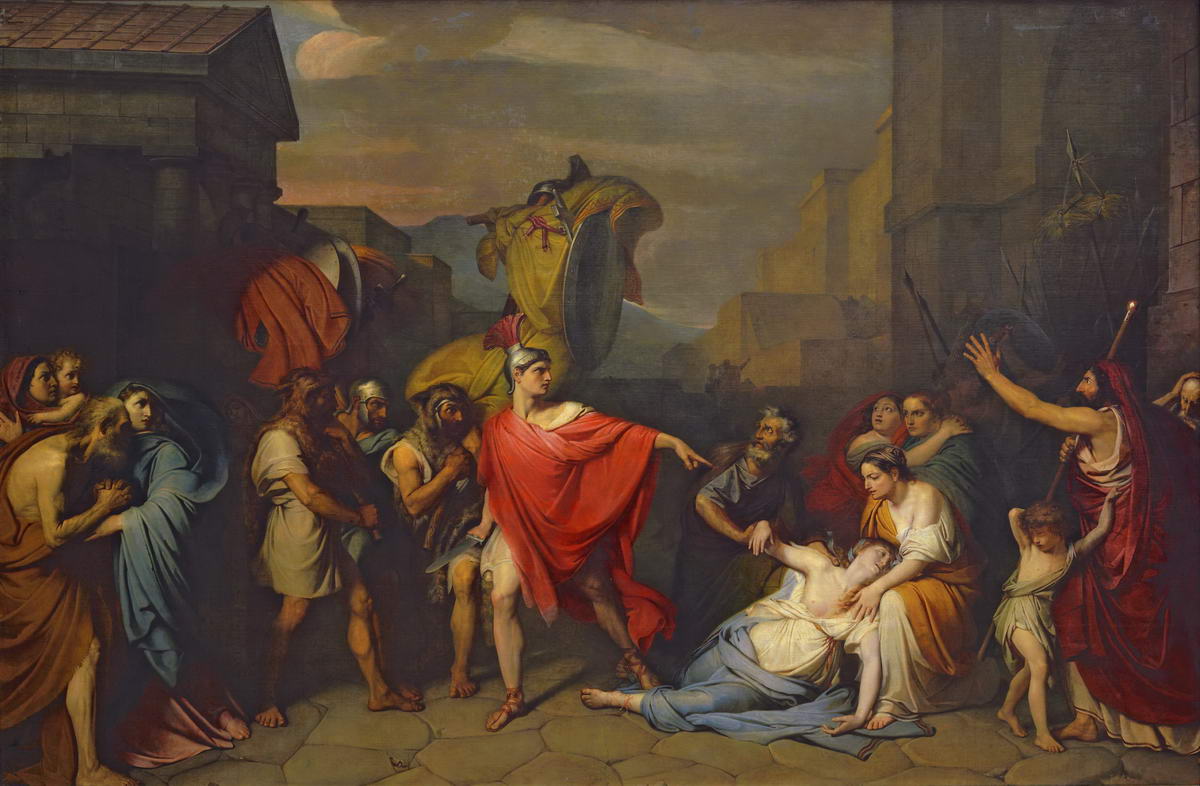


Сюжет картины 23-летний Федор Бруни заимствует из легендарного прошлого Рима, когда Рим враждовал с городом Альба-Лонга. Судьба этой многолетней вражды должна была решиться в поединке между тремя братьями Горациями – со стороны Рима, и тремя братьями Куриациями – со стороны Альба-Лонга. Оставшийся в живых после сражения победитель Гораций по возвращении в Рим встречает сестру Камиллу, оплакивающую своего жениха, одного из Куриациев. Разгневанный брат поражает её мечом. Поступок героя вызывает у окружающих не уважение, но скорее ужас и сострадание к его жертве. Герой одинок, между ним и согражданами – трагическое непонимание. Полотно, названное Бруни «Триумф Горация», уже современниками было названо иначе: «Смерть Камиллы, сестры Горация».
Действие этого полотна разворачивается перед нами подобно классическому фризу: тщательно моделирована пластика фигур, расставленных как на сцене, величавы их жесты, благородно ниспадают крупные складки драпировок. Алый плащ и эффектная поза выделяют помещенного в центре героя – его указующая рука точно совпадает с диагональю композиции.
Живописец.
Академик Императорской Академии художеств (с 1834). Почетный член Болонской и Миланской академий искусств, почетный профессор Флорентийской Академии художеств и Академии Св. Луки в Риме. Родился в Милане в семье художника-декоратора А. Бруни. В 1807 приехал с отцом в Россию. Учился в Академии художеств у А. Е. Егорова, А. И. Иванова и В. К. Шебуева (1809-1818). Начиная с 1819 подолгу жил и работал в Италии. С 1836 преподавал в Академии художеств, профессор, с 1855 по 1871 - ректор, с 1866 заведовал мозаичным отделением. Почти все крупные полотна завершил и впервые выставил в Италии. Один из создателей росписей кафедрального Исаакиевского собора в Петербурге и Храма Христа Спасителя в Москве. С 1849 по 1864 - хранитель живописного отдела Эрмитажа, много сделал для пополнения коллекций. Один из наиболее значительных представителей русской академической школы, автор полотен на исторические и библейские темы, портретов. Автор альбома "Русская история в гравюрах", многочисленных эскизов икон и стенных росписей.

23-year-old Fyodor Bruni took this subject from the legendary past when Rome was at war with the city of Alba Longa. The fate of this longstanding feud was to be determined in the fight between the three brothers Horatii – from the side of Rome, and three brothers Curiatii – from Alba Longa. Returning to Rome, the victorious survivor Horatius sees his sister Camilla mourning the death of her fiancé, one of Curiatii, instead of her brothers’. Enraged, her brother strikes her with his sword. The act of the hero is met by part of the witnesses with horror and compassion for his victim.
These emotions are also communicated to the audience; and it is no coincidence that F. A. Bruni’s painting, initially named by the author “Triumph of Horatius”, was renamed by his contemporaries to "The Death of Camilla, Sister of Horatius".
But here, like in no other Russian historical painting, the triumph of community spirit and determination to sacrifice their personal and most precious everything for the public debt is immortalized. In a strong imperative gesture of Horace, in mimics of other characters, in colour scheme, a drama so intense is expressed, as could not be found in previous works by the Russian historical painters.
The action of this painting unfolds before us like a classical frieze: the plastic of figures placed on the stage is carefully modelled, their gestures are majestic, large folds of the draperies fall nobly. A scarlet cloak and a striking pose lay emphasis on the hero placed in the centre – his pointing hand is exactly congruent with the diagonal composition. The painting’s clear classic scheme echoes J. L. David's painting "Oath of the Horatii" (1784, Louvre).
The painting was given to the Russian Museum in 1897 from the Museum of the Academy of Arts; earlier (from 1824 to 1833) it was stored in the estate of the Prince Baryatinsky; in 1833 it was exhibited and in 1834 purchased by the Imperial Academy of Arts.
Painter, engraver, author of religious and history compositions, portraitist. Son of the painter and sculptor Antonio Baroffi-Bruni. Moved to Russia with his father (1807). Studied under Alexei Yegorov, Andrei Ivanov and Vasily Shebuyev at the Imperial Academy of Arts (from 1809). Graduated with a first-class degree (1818). Moved to Rome to con¬tinue his art education (1819). Returned to Russia and painted portraits and icons for churches and cathedrals in St Petersburg and environs (1835-38). Lived and worked in Rome (1838-43, 1843-45). Honorary member of the Academies of Art of Bologna and Milan, professor of the Florentine Academy of Arts and St Luke''s Academy in Rome. Taught at the Imperial Academy of Arts (1836-38, 1846-71). Second-class professor (1836), first-class professor (1846), rector of painting and sculpture (1855-71). Curator of the Imperial Hermitage picture gallery (1849-64), headed the mosaic studio at the Imperial Academy of Arts (from 1866



